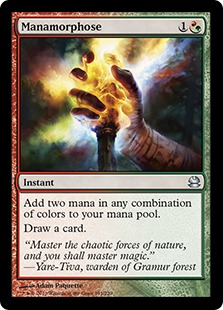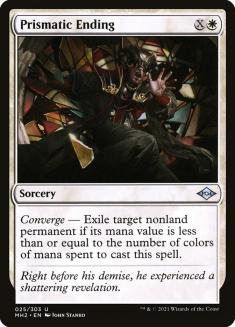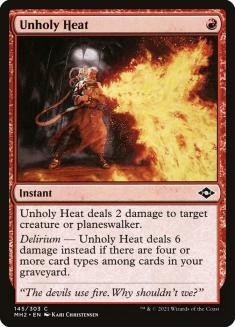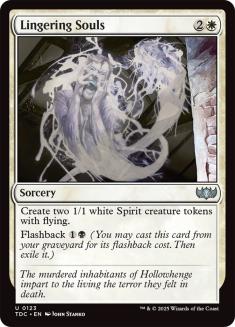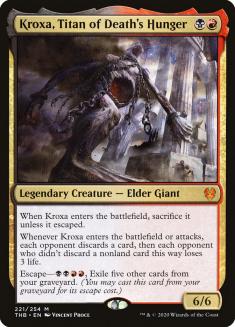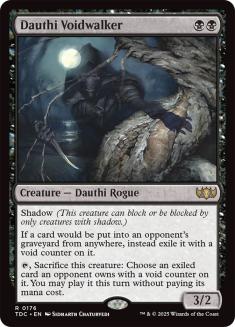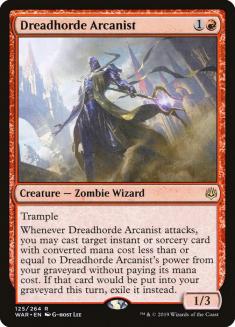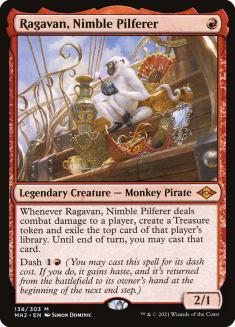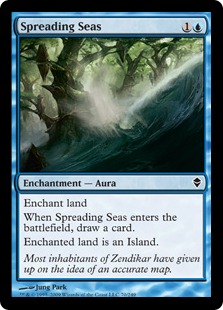Since previews for Modern Horizons 2 started, I’ve had Ragavan, Nimble Pilferer on the brain. Never did I think another one-drop in the set could be better. Never did I think another one-drop in the same color was better. Holy crap was I wrong.
Dragon’s Rage Channeler is the future.
I don’t know how else to explain it other than that. At first, I didn’t think it was all that good. Getting delirium on the second turn is pretty difficult, right? Turns out that Dragon’s Rage Channeler is perfectly capable of turning on delirium on its own without trouble. A single Mishra’s Bauble or Manamorphose can make things trivial. Even in a deck that doesn’t have dedicated card types to put directly into the graveyard to fuel delirium, just casting a few cantrips or removal spells is probably enough to get it turned on.
Like Ragavan, Dragon’s Rage Channeler won’t supplant Goblin Guide and Monastery Swiftspear in Modern Burn. Those two creatures excel at damage output, and it will be hard to topple them from their throne. However, in virtually any other deck, both Ragavan and Dragon’s Rage Channeler offer unique play patterns for various strategies. My thoughts on Ragavan appear below.
Dragon’s Rage Channler (DRC) is itself an enabler for some decks, filling the graveyard and fueling itself. If you’re playing Arclight Phoenix or some other graveyard shenanigans, and actually care about attacking for medium-sized chunks of damage, DRC is outrageous. It’s one of the best one-drops in the entire game of Magic and it’s been out for about two weeks. It’s excellent in Legacy and Modern, and is threatening to stand beside or even supplant Delver of Secrets in many of the decks we’ve come to know and love. In Modern specifically, I think DRC is far better than Delver of Secrets, or any other option that we could fit in that spot. We’ve seen Delver of Secrets have a semi-comeback in Modern thanks to Lurrus of the Dream-Den, but virtually all decks that would want Delver can now just play DRC.
The most important aspect of DRC is that it triggers on all the same stuff as prowess, which makes it ludicrous as the third one-drop alongside Monastery Swiftspear and Soul-Scar Mage in various Mono-Red Prowess decks. If you care about just casting a high number of spells, you can put cards like Lava Dart into the graveyard while you cycle Manamorphose or Mishra’s Bauble, all while fueling your other prowess threats. If you want to go a bit more midrange, you can effectively mill over anything with graveyard synergy, like Kroxa, Titan of Death’s Hunger or Lingering Souls. DRC really does it all, and it does it while costing one mana and attacking for three points in the air.
I’ve seen quite a few cool DRC decks already, and today we’ll go over a few builds that I’m really drawn to. First up is a revival of an old favorite from everyone’s favorite Modern streamer.
Creatures (16)
Lands (18)
Spells (26)
- 4 Lightning Bolt
- 4 Lava Dart
- 4 Mishra's Bauble
- 4 Manamorphose
- 2 Maximize Velocity
- 4 Light Up the Stage
- 4 Faithless Salvaging
Sideboard

This is probably the best shell I’ve seen for DRC, which is why I put it first even though it’s not my list. Aspiringspike has been doing a ton of work in Modern, consistently coming up with unique brews and puts them through their paces on stream. The dude is a workhorse, and continuously pushes the boundaries on deckbuilding. This Mono-Red Phoenix deck immediately caught my attention, both from the perspective of it being one of my favorite archetypes and also because of how fluidly and easily he was able to take advantage of DRC.
The moment I milled over Lava Dart with DRC, I was sold. Every game where you start with DRC is drastically different from the games where you don’t. It pairs nicely with Arclight Phoenix because it flies, and deals damage in the same chunks of three. It allows you to sculpt your draws while applying an absurd amount of pressure. It also only costs one mana.
Turning on Arclight Phoenix has been rather difficult as of late because they banned Faithless Looting in Modern. However, a recent addition to the format has helped alleviate some of that pressure.
While Faithless Salvaging is not anywhere close to Faithless Looting in terms of raw power, the ability to discard Arclight Phoenix while cycling through cards is pretty cool. There’s also the added benefit of Faithless Salvaging acting like card advantage when your hand is empty, as you can cast it as your last card and get a fresh one without the cost of discarding. It helps you hit your spell threshold for Arclight Phoenix by having rebound, costs zero mana on the turn where you’re trying to go off with Arclight Phoenix, and gives you a way to discard extra lands or dead removal in the wrong matchup. It’s solid.
Faithless Salvaging won’t be winning any awards for Best Spell in Modern Horizons 2, but it plays a lot better than it looks on paper. I was pretty disappointed by it when I first read it, but watching it play out a few times has given me new hope that it’s actually the enabler than Arclight Phoenix needed to get back on the map.
These two spells act as free enablers for DRC. It’s unfortunate that Arclight Phoenix specifies instants and sorceries, unlike DRC and all the prowess creatures. I still think it’s more than worth it to play Mishra’s Bauble in this deck, as the free surveil from DRC is outrageous when trying to dig for Arclight Phoenix or even a Lava Dart to cast for free. Mishra’s Bauble being an artifact also helps get DRC online and attacking more quickly, both because of the card type and the free surveil. The fact that it replaces itself is just icing on the cake.
Manamorphose is probably the best card in your deck because it enables DRC and Arclight Phoenix and all your prowess cards without costing you mana. Expect both of these cards to show up often with DRC. Right now, I feel like too few people are playing Manamorphose in their DRC decks, but I expect that to change once people realize it’s just free.
Mono-Red Phoenix lost so much traction with the banning of Faithless Looting, I didn’t think it would ever come back, but DRC and a few other goodies have helped revive it. Like a phoenix from the ashes, it will rise again.
Creatures (16)
Lands (19)
Spells (25)

If you’re a fan of Death’s Shadow, this version offers a boatload more and stronger interaction than your traditional builds. We go hard on disruption so that we don’t have to play Temur Battle Rage, a card that is traditionally good at helping break through stalls or racing combo decks. Because combo decks are so few and far between these days, I don’t know that Temur Battle Rage is worth keeping around. I also think Temur Battle Rage is significantly worse when your other creatures aside from Death’s Shadow and Scourge of the Skyclaves are rather small. The prowess creatures were often big enough to make Temur Battle Rage lethal, but that’s not the case with the suite of creatures we’ve chosen.
This is one of those cards that you don’t know just how good it is until you cast it for the first time. It’s much more efficient than it actually looks, and gives us quite a few ways to interact with a number of problematic permanents that you’d otherwise be struggling to interact with. Cards like Aether Vial or Amulet of Vigor are powerful in the early turns, so having a removal spell that can kill those or Noble Hierarch is ludicrous.
As the game progresses, Prismatic Ending can answer more stuff, but I’ve been thinking of it more like Fatal Push that can kill Utopia Sprawl. It’s been so impressive that I can’t imagine playing a version that doesn’t incorporate it. Rakdos decks have a tough time dealing with some of the enchantments or other random stuff that our opponents could throw at us. It’s exciting to get a removal spell that’s so versatile.
Another card you’ll see in a lot of the same decks as DRC, Unholy Heat is on my short list for one of the best red removal spells ever printed behind Lightning Bolt. I no longer feel the need to play Fatal Push in any deck that can reasonably and aggressively hit delirium and is playing red, because Unholy Heat kills just about everything. Fatal Push suffers from not being able to kill some of the game’s mid-size creatures that have some cost reduction. Delve creatures like Gurmag Angler or Murktide Regeant are problematic for a number of reasons, but Unholy Heat can usually take them down without much trouble.
The most ludicrous part of Unholy Heat is that it hits just the right number for most of Modern’s playable threats. Primeval Titan is about as big as it gets, and having a one-mana removal spell that can kill it in a red deck is busted. The only reason we’re not playing it maindeck is because I’m still in love with Seal of Fire, but having that diversity to bring in a removal spell that’s good against Tarmogoyf and Primeval Titan makes our sideboard plans flexible. I love it.
Having a few threats that can be milled over or discarded via DRC gives us some breathing room against the more controlling decks in the format. Threats that are hard to deal with on a one-for-one basis can give headaches to those opponents who choose to play Path to Exile or similar. A later-game Lingering Souls can be an absolute nightmare for most fair decks to play against.
Kroxa is not exactly broken in a deck like this, but I like having access to one to draw toward. It’s also a creature that can be easily put into the graveyard to enable DRC. As we pound their hand and life total, having a big threat from the graveyard like Kroxa can squeeze our opponent and shrink their outs. Those bursts of damage from Kroxa, as well as the recursive nature, make it good in any attrition battle. Like Lingering Souls, Kroxa gives you a threat that provides multiple cards’ worth of value and can be milled over by DRC for some added virtual card advantage.
Next up, a similar shell but more midrange instead of all-out aggressive.
Creatures (18)
- 4 Dreadhorde Arcanist
- 2 Kroxa, Titan of Death's Hunger
- 4 Dragon's Rage Channeler
- 4 Ragavan, Nimble Pilferer
- 4 Dauthi Voidwalker
Lands (21)
Spells (21)

Originally from Adam Snook, this build of Mardu Arcanist is a little lower to the ground thanks to the new one-drop red threats from Modern Horizons 2. Both Ragavan and DRC add a different dimension to a deck that would normally be pretty slow. The aggressive slant allows you to play lower to the ground, facilitates Lurrus, and gives you some ways to punish the slower opponents. One-mana cards that are good in the later turns of the game are extremely valuable to midrange strategies.
This all-star from Modern Horizons 2 gives us a little more pressure and adds an X-factor that we just didn’t have before. Not only does Dauthi Voidwalker hose all graveyard-related strategies if cast quickly enough, it also shines when paired with Thoughtseize or removal on a big target. The ability to steal an opposing planeswalker or something scarier by just tapping Dauthi Voidwalker makes it terrifying to play against. When coupled with the aggressive slant we’re already leaning toward, the unblockable three damage per turn is stout.
If left unchecked, Dreadhorde Arcanist will threaten to ruin your opponent’s day. Playing one-mana creatures that draw removal makes Dreadhorde Arcanist more likely to stick, ultimately adding to the pressure that your creature suite applies to the game. Overloading your opponent’s removal is a very real strategy in a deck like this, and having multiple one-mana creatures that are “kill on sight” means we’re gonna have games where we absolutely steamroll our opponent because they only drew one Lightning Bolt.
Dreadhorde Arcanist limits the different card types I want to play, yet offers such landslide gameplay that I’m currently under the impression that it’s the best two-drop for the job outside of playing another color. However, I’m not entirely sold that playing Mardu is better than Jund or any other color combination. We’re in the experimental stages with DRC, so we must keep an open mind when it comes to deckbuilding and testing.
Next up, let’s try out DRC in a shell featuring an actual-factual delve card!
Creatures (14)
Lands (19)
Spells (27)
- 4 Lightning Bolt
- 4 Serum Visions
- 4 Mishra's Bauble
- 4 Thought Scour
- 2 Fire
- 3 Force of Negation
- 4 Expressive Iteration
- 2 Unholy Heat
Sideboard


We’re not playing Delver of Secrets because it’s not easy to transform and playing stuff like Mishra’s Bauble makes it even harder. Delver of Secrets has always had tension in Modern because we can’t play Ponder or Preordain to help it transform, but we also need to play enough threats to fight through the removal. Playing the 20/20/20 split of lands, creatures, and ways to transform Delver of Secrets has always been the benchmark. In Modern, we have to skew toward more instants and sorceries because we don’t have many ways to manipulate our deck efficiently, but Mishra’s Bauble just makes it even more awkward.
Beause we aren’t playing Delver, I’ve decided to replace it with Ragavan, Nimble Pilferer. This card will be showing up with DRC for a long time to come. They’re both great threats that function well early or late, meaning they’re both heading into the same types of decks. The mana advantage you can gain from Ragavan allows for some absurd Expressive Iterations on the second turn, since you can cast it before playing your land for the turn thanks to the Treasure token. We also thrive in playing multiple spells in the same turn, so short bursts of mana are pretty incredible in Delver-style decks.
We’ve seen Ragavan do some messed-up stuff in a short period of time. I’m loving the play patterns, as they tend to skew interactive, though the landslide nature is a bit concerning at times. Riding the rush of mana and cards is exhilarating. Is this what it feels like to cast Seething Song?
Spreading Seas is probably worth finding a deck where we can play it in the main. Urza’s Saga gets absolutely blasted by this card because of a weird rules interaction with Sagas. For clarity, a Spreading Seas makes them sacrifice the Urza’s Saga immediately, meaning they don’t even get to keep it around as a useless-ish Island. Instead, we get a two-mana Stone Rain that draws us a card. It’s an obvious nod to Urza’s Saga because of this interaction, but it has legs against Tron and other land-based archetypes too. The fact that it cycles means we get to keep our raw card count high, which is important for both Subtlety and Force of Negation.
Lastly, let’s look at a much more controlling, though still very aggressive, Grixis version.
Creatures (14)
- 4 Death's Shadow
- 1 Snapcaster Mage
- 1 Young Pyromancer
- 4 Dragon's Rage Channeler
- 4 Ragavan, Nimble Pilferer
Lands (19)
Spells (27)

Death’s Shadow just so happens to fit the shell perfectly, but we’re not quite aggressive enough to take full advantage of Scourge of the Skyclaves. It’s actually rather difficult to get Scourge of the Skyclaves online if your opponent doesn’t deal themselves any damage at the beginning of the game. This is why Monastery Swiftspear was great in that version, because that one point of chip damage on the first turn allowed you to curve out naturally. Without that sometimes guaranteed one point of damage, Scourge just might not be worth it.
DRC Is the MVP
I love that all these Dragon’s Rage Channeler decks float somewhere between aggro and midrange, allowing you to build in one direction or the other. Cards that offer dynamic gameplay at a cheap cost opens up all sorts of avenues in deckbuilding.
Nuance inside of an archetype is where I always want to live. It’s a deckbuilder’s dream, just always searching for the perfect build for the exact metagame that shows up. Dragon’s Rage Channeler is one of those rare cards that not only facilitates certain archetypes core components, but also apply enough pressure to make your opponent squirm.
The disruption you pair with a card like Dragon’s Rage Channeler will ultimately decide what type of game you’re trying to play. Lava Dart and Lava Spike point you in a polarizing direction, making the buff and flying a legitimate threat to your opponent’s life total. Force of Negation or Thoughtseize means you want to play ball, but only on your terms.
There are so many awesome brews in Modern right now that it’s hard to pick a favorite. I’ve been bouncing around constantly trying to find the perfect fit for me and Dragon’s Rage Channeler. Whatever version you decide on, you can rest assured that the card will perform.
Dragon’s Rage Channeler is a truly marvelous card. If you’ve ever been a fan of Delver of Secrets, you should love virtually every deck on this list. There’s nothing more to say.





